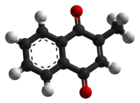Menadione
 |
|
 |
|
| Names | |
|---|---|
|
IUPAC name
2-Methylnaphthalene-1,4-dione
|
|
| Other names
Menaphthone; Vitamin K3; β-Methyl-1,4-naphthoquinone; 2-Methyl-1,4-naphthodione; 2-Methyl-1,4-naphthoquinone
|
|
| Identifiers | |
|
3D model (JSmol)
|
|
| ChEBI | |
| ChemSpider | |
| DrugBank | |
| ECHA InfoCard | 100.000.338 |
| KEGG | |
|
PubChem CID
|
|
| UNII | |
|
|
|
|
| Properties | |
| C11H8O2 | |
| Molar mass | 172.18 g·mol−1 |
| Appearance | Bright yellow crystals |
| Density | 1.225g/cm3 |
| Melting point | 105 to 107 °C (221 to 225 °F; 378 to 380 K) |
| Boiling point | 304.5 °C (580.1 °F; 577.6 K) @ 760mmHg |
| Insoluble | |
| Pharmacology | |
| B02BA02 (WHO) | |
| Hazards | |
| Flash point | 113.8 °C (236.8 °F; 386.9 K) |
| Lethal dose or concentration (LD, LC): | |
|
LD50 (median dose)
|
0.5 g/kg (oral, mouse) |
|
Except where otherwise noted, data are given for materials in their standard state (at 25 °C [77 °F], 100 kPa).
|
|
|
|
|
| Infobox references | |
Menadione is an organic compound with the formula C6H4(CO)2C2H(CH3). It is an analog of 1,4-naphthoquinone with a methyl group in the 2-position. It is occasionally used as a nutritional supplement because of its vitamin K activity.
It is sometimes called vitamin K3, although derivatives of naphthoquinone are not naturally occurring chemicals and therefore do not qualify as vitamins, and without the side chain in the 2-position they cannot exert all the functions of the K vitamins. Menadione is metabolized by the human body into K2 which uses alkylation to yield menaquinones (MK-n, n=1-13; K2 vitamers), hence is better classified as a provitamin.
It is also known as "menaphthone".
It is an intermediate in the chemical synthesis of vitamin K by first reduction to the diol menadiol, which is suscepible to coupling to the phytol.
Despite the fact that it can serve as a precursor to various types of vitamin K, menadione is generally not used as a nutritional supplement in economically developed countries. Menadione for human use at pharmaceutical strength is available in some countries with large lower income populations. It is used in the treatment of hypoprothrombinemia outside of the United States.
Large doses of menadione have been reported to cause adverse outcomes including hemolytic anemia due to glucose-6-phosphate dehydrogenase deficiency, neonatal brain or liver damage, or neonatal death in some rare cases. In the United States, menadione supplements are banned by the U.S. Food and Drug Administration because of their potential toxicity in human use.
Low-dose menadione is still used as an inexpensive micronutrient for livestock in many countries. Forms of menadione are also included in some pet foods in developed countries as a source of vitamin K. These doses have yielded no reported cases of toxicity from menadione in livestock or pets.
...
Wikipedia
